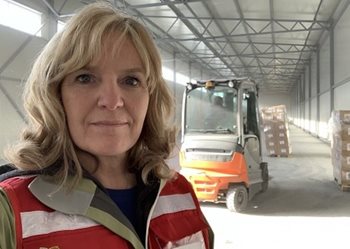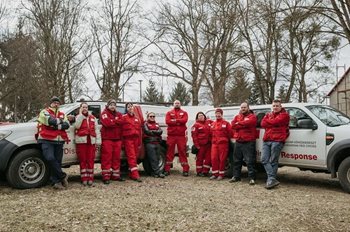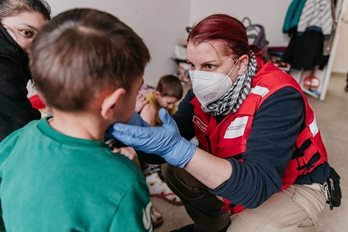By: Kathy Mueller, senior communications advisor

It has now been almost two months since I packed my bags and headed to Europe to support the Red Cross response to the conflict in Ukraine.
I can’t help but think of the millions of people who have also had to leave their homes, under very different circumstances, unsure of what they will eventually return to. The word “millions” doesn’t do these people justice. They aren’t just some anonymous number. They are mothers, daughters, sons, grandmothers, grandfathers, aunts, uncles. They come from all walks of life. Some are students, some run businesses, some are teachers, lawyers. Some are old enough to remember other wars previously fought on the European continent.
Uzhhorod, Ukraine is a three to four hour drive east of where I am based in Budapest, Hungary. On the western border of the country, an estimated 400,000 people have fled there, in search of safety. They live in whatever space can be found – factories, sports complexes, cinemas, schools. Schools there closed temporarily to accommodate the influx of people.

While we are a large team, now made up of more than 100 people from around the world, it is the staff and volunteers at the Ukrainian Red Cross and seven neighbouring National Red Cross Societies who are the backbone of our humanitarian response.
Thousands of Red Cross volunteers have been on the ground since day one. In Ukraine, even though many have been directly impacted, these dedicated volunteers continue to risk their own lives to make sure that basic, but critical aid such as food and water gets to people sheltering in subway systems and underground bomb shelters. When possible, they help people get to safety.
These volunteers also provide first aid at border crossings and help distribute relief supplies from the Canadian Red Cross, thanks to Global Affairs Canada and other international partners. In five weeks, they have reached more than 400,000 people.
In bordering countries, Red Cross teams are just as busy, helping the more than five million people who have made days-long treks to cross borders. Mainly mothers, children and grandparents, they all need a place to sleep, food to eat, water to drink, access to health care.

The international contingent of Red Cross responders is here at the invitation of these local National Red Cross Societies. It’s my job to help raise awareness about what is happening on the ground, what people need, and how Canadians can help.
I am proud to wear my Canadian Red Cross vest and am honoured when people share their stories with me. I remember one man from Sumy, Ukraine, who talked about the bombs being his alarm clock. Or Anna, a mother from Uzhhorod, who became a Red Cross volunteer one week after the start of the conflict because she wanted to help people.
My international colleagues and I can support with our technical expertise, but it is the local Red Crossers who are the real experts. They know the region, the history, how intertwined the countries and their people are. They know the culture, the customs, the language.
This is the strength of the Red Cross and Red Crescent Movement: locally-based action with global support.
People living in Canada wishing to make a financial donation to the Ukraine Humanitarian Crisis Appeal can do so online, by calling 1-800-418-1111, or by texting UKRAINE to 20222 to donate $10.
Related stories: